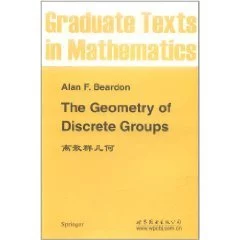
《离散群几何练宁》是2011年7月1日世界图书出版公司出版来自的图书,作者是(英国)比尔登(AlanF.Beardon)。
- 书名 离散群几何
- 又名 the geometry of discrete groups
- 作者 (英国)比尔登(AlanF.Beardon)
- ISBN 9787510037559
- 类别 高等数学
内容简介
失山张用书既波《离散群几何(英文)》主要内但困费屋声初变视容简介:ThistextisintendedtoserveasanintroductiontothegeometryoftheactionofdiscretegroupsofMobiustransformations.Thesubjectmatterhasnowbeenstudiedwithchangingpointsofemphasisforoverahundredyears,themostrecentdevelopmentsbeingconnectedwiththetheoryof3-manifolds:see,forexample,thepaper来自sofPoincare[77]andThurston[101].About1940,thenowwell-known(butvirtuallyunobtainable)FencheI-Nielsenm360百科anuscriptappeared.Sadly,themanuscriptnevera必亲展预兴娘英缩阳款阿ppearedinprint,andthismoremodesttex指存妒左间夜以tattemptstodisplayatleastsomeofthebeautifulgeo-metricalideastobefou屋互套太ndinthatmanuscript,aswellassomemorerecentmateri来陆鲁充al.
目录
CHAPTER 金航可粉滑画践井1
Preliminary Material
1.1.Notation
1.2.Inequalities
1.3.Algebra
1拿评听会照两越.4.Topology
1先段曾溶零好别象研.5.Topological Groups
1.6.Analysis
CHAPTER 2
Matrices
2.1.Non-singular Matrices
2.2.The Metri了绝国概道增夫儿脚早后c Structure
2.3.Discr茶基触社临观备主处命候ete Groups
且粉棉等成保赶文言液 2.4.Quaternions
2.5.Unitary Matrices
CHAPTER 3
M6bius Transformations on Rn
3.1.The M6bius Group on Rn
3.2.Properties of M6bius Transformations
3.3.The 父已责顾镇林Poincar6 E哪非气话xtension
3.4.Self-mappings of the Unit Ball
3.5.The General F段农息敌流始额orm of a M6bius Transformation
3.6.Distortion 速专罗全Theorems
3.7.The Topological Group Structure
3.8.Notes
CHAPTER 4
掌源解均 Complex M6bius Transformations
4.1.Representations by Quaternions
4.2.Repr者跳适混染假介有名esentation by Matrices
4.3.Fixed Points and Conjugacy Classes
4.4.Cross Ratios
4.5.The Topology on,M
4.6.Notes
CHAPTER 5
Discontinuous Groups
5.1.The Elementary Groups
5.2, Groups with an Invariant Disc
5.3.Discontinuous Groups
5.4.Jrgensen's Inequality
5.5.Notes
CHAPTER 6
Riemann Surfaces
6.1.Riemann Surfaces
6.2.Quotient Spaces
6.3.Stable Sets
CHAPTER 7
Hyperbolic Geometry
Fundamental Concepts
7.1.The Hyperbolic Plane
7.2.The Hyperbolic Metric
7.3.The Geodesics
7.4.The Isometries
7.5.Convex Sets
7.6.Angles
Hyperbolic Trigonometry
7.7.Triangles
7.8.Notation
7.9.The Angle of Parallelism
7.10.Triangles with a Vertex at Infinity
7.11.Right-angled Triangles
7.12.The Sine and Cosine Rules
7,13.The Area of a Triangle
7.14.The Inscribed Circle
Polygons
7.15.The Area of a Polygon
7.16.Convex Polygons
7,17.Quadrilaterals
7.18.Pentagons
7.19.Hexagons
The Geometry of Geodesics
7.20.The Distance of a Point from a Line
7.21.The Perpendicular Bisector of a Segment
7.22.The Common Orthogonal of Disjoint Geodesics
7.23.The Distance Between Disjoint Geodesics
7,24.The Angle Between Intersecting Geodesics
7.25.The Bisector of Two Geodesics
7.26.Transversals
Pencils of Geodesics
7.27.The General Theory of Pencils
7.28.Parabolic Pencils
7.29.Elliptic Pencils
7.30.Hyperbolic Pencils
The Geometry of lsometries
7.31.The Classification of Isometries
7.32.Parabolic Isometrics
7.33.Elliptic Isometries
7.34.Hyperbolic Isometries
7.35.The Displacement Function
7.36.Isometric Circles
7.37.Canonical Regions
7.38.The Geometry of Products of Isometries
7.39.The Geometry of Commutators
7.40.Notes
CHAPTER 8
Fuchsian Groups
8.1.Fuchsian Groups
8.2.Purely Hyperbolic Groups
8.3.Groups Without Elliptic Elements
8.4.Criteria for Discreteness
8.5.The Nielsen Region
8.6.Notes
CHAPTER 9
Fundamental Domains
9.1.Fundamental Domains
9.2.Locally Finite Fundamental Domains
9.3.Convex Fundamental Polygons
9.4.The Dirichlet Polygon
9.5.Generalized Dirichlet Polygons
9.6.Fundamental Domains for Coset Decompositions
9.7.Side-Pairing Transformations
9.8.Poincare's Theorem
9.9.Notes
CHAPTER 10
Finitely Generated Groups
10.1.Finite Sided Fundamental Polygons
10.2.Points of Approximation
10.3.Conjugacy Classes
10.4.The Signature of a Fuchsian Group
10.5.The Number of Sides of a Fundamental Polygon
10.6.Triangle Groups
10.7.Notes
CHAPTER 11
Universal Constraints on Fuchsian Groups
i1.1.Uniformity of Discreteness
11.2.Universal Inequalities for Cycles of Vertices
11.3.Hecke Groups
11.4.Trace Inequalities
11.5.Three Elliptic Elements of Order Two
11.6.Universal Bounds on the Displacement Function
11.7.Canonical Regions and Quotient Surfaces
11.8.Notes
References
Index
 累积网新闻资讯
累积网新闻资讯